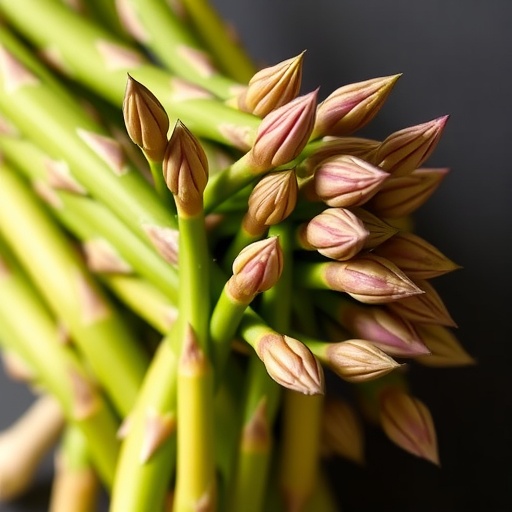As the quest for longevity and youthful vitality intensifies in modern society, groundbreaking research conducted by an intrepid team led by Wan, R., Cai, Z., and Liu, Z. is pushing the boundaries of what we understand about anti-aging ingredients derived from nature. Their recent publication in BMC Complementary Medicine and Therapies unveils remarkable findings related to Asparagus cochinchinensis, an underappreciated botanical with rich potential to combat age-related decline. The study remarks on the profound wisdom encapsulated in natural products, the potency of which has long been marveled at in traditional medicine practices worldwide.
This enticing research scrutinizes the spectrum-effect relationship between chemical components found in Asparagus cochinchinensis and their efficacy in promoting longevity. By decoding the complex interactions and synergies among various active compounds, the researchers unlock a treasure trove of possibilities that may yield novel anti-aging formulations. The implications of these efforts reverberate across multiple fields—from pharmaceuticals to cosmetics—creating a cascade effect that could reshape our approach to age management.
At the heart of this intricate study lies an ambitious goal: to systematically identify and elucidate the active ingredients that contribute to the anti-aging properties of this versatile plant. Known for its traditional ethnobotanical applications, Asparagus cochinchinensis has been heralded for its health benefits, but until now, scientific validation has been limited. The authors employ cutting-edge analytical techniques, which serve not only to catalog these active ingredients but also to establish correlations between their chemical structures and observed biological effects.
In the pursuit of understanding how these compounds interact within biological systems, the researchers deployed a multifaceted approach, incorporating high-performance liquid chromatography alongside various bioassays. This rigorous methodology ensures that the findings are not merely anecdotal but grounded in empirical evidence. As such, the research stands as a testament to the power of interdisciplinary collaboration in unveiling the mysteries of nature’s pharmacopoeia.
The study presents findings that not only validate the health claims surrounding Asparagus cochinchinensis but also pioneer a new understanding of its anti-aging mechanisms. For instance, certain flavonoids and saponins identified in the plant demonstrate significant antioxidant activity, a key feature in mitigating oxidative stress—a leading contributor to cellular aging. This nuanced understanding of molecular interactions aids in the delineation of how specific compounds may behave synergistically, enhancing their overall efficacy.
Moreover, the authors explore the potential roles of these active ingredients in various cellular pathways related to longevity. They illuminate the impact of these compounds on cellular senescence and inflammation, both critical hallmarks of aging. By presenting evidence of their protective actions at the cellular level, the study lays the groundwork for future therapeutic interventions aimed at slowing the aging process.
The social relevance of these findings cannot be overstated. In an age where cosmetic industries are continually evolving, the insights garnered from the research promise to enrich product development in ways that are both innovative and responsible. As consumers increasingly seek transparency and efficacy from their anti-aging products, the validation of naturally derived ingredients places Asparagus cochinchinensis into the spotlight, presenting manufacturers with exciting opportunities to formulate new solutions to address age-related concerns.
Furthermore, the implications of this research ripple beyond the cosmetic and pharmaceutical industries; they also resonate in the realm of dietary supplementation. The incorporation of Asparagus cochinchinensis extract into dietary regimens could represent a proactive step in promoting longevity, prompting a shift in how consumers view nutrition and holistic health. The dual benefit of nutritional support and aesthetic enhancement could prove irresistible in the wellness market.
Nonetheless, the journey of translating these scientific discoveries into real-world applications will require ongoing research and collaboration between scientists, industry leaders, and healthcare professionals. Continued clinical trials will be essential to ascertain the long-term safety and efficacy of the identified compounds within diverse populations. Furthermore, addressing potential regulatory hurdles will be crucial to facilitate market entry and accessibility.
In summary, this remarkable study encapsulates the essence of scientific progress: transforming nature’s bounty into effective solutions for modern challenges. The active agents uncovered from Asparagus cochinchinensis not only advance our understanding of anti-aging but also herald a shift towards embracing natural ingredients in health and wellness formulations. The excitement surrounding this research is palpable—it holds promise for shaping a future where aging gracefully is anchored in both science and nature.
As awareness grows about the importance of harnessing nature’s wisdom, we anticipate increased interest in similar studies that explore the vast potential of plant-derived compounds in promoting health span. The excitement surrounding the research conducted by Wan and colleagues serves as a reminder of the untapped potential lying within nature, waiting to be explored, researched, and ultimately celebrated. The knowledge gathered from their work is a pivotal step toward fostering a culture that deeply values the synergy between natural healing and scientific innovation.
Ultimately, this research invites a collective reflection on our approach to aging. While societal norms often skew towards fearing the passage of time, studies like these challenge us to view aging as an opportunity for enhancement rather than decline. The identification of potent anti-aging ingredients in Asparagus cochinchinensis invites us to rethink our biological narratives, forging a new path that embraces longevity, vitality, and holistic wellness.
By transforming findings from the realm of scientific research into actionable insights, we take significant strides towards redefining our relationship with age, encouraging a global community to appreciate the beauty of seasoned lives well-lived.
Subject of Research: Identification of anti-aging ingredients from Asparagus cochinchinensis based on the spectrum-effect relationship.
Article Title: Identification of active anti-aging ingredients from asparagus cochinchinensis based on the spectrum-effect relationship.
Article References:
Wan, R., Cai, Z., Liu, Z. et al. Identification of active anti-aging ingredients from asparagus cochinchinensis based on the spectrum-effect relationship.
BMC Complement Med Ther 25, 428 (2025). https://doi.org/10.1186/s12906-025-05166-5
Image Credits: AI Generated
DOI: https://doi.org/10.1186/s12906-025-05166-5
Keywords: Anti-aging, Asparagus cochinchinensis, Longevity, Natural Ingredients, Spectrum-Effect Relationship, Phytochemistry, Traditional Medicine, Health Innovations.
Tags: active ingredients in age managementanti-aging compounds in Asparagus cochinchinensisbotanical research on agingchemical components of Asparagus cochinchinensiscombating age-related decline with nature’s remediesethnobotanical applications of Asparagusimplications of research in pharmaceuticals and cosmeticsnatural ingredients for longevitynovel anti-aging formulationsspectrum-effect relationship in herbal medicinetraditional medicine and anti-agingunlocking potential of natural products





